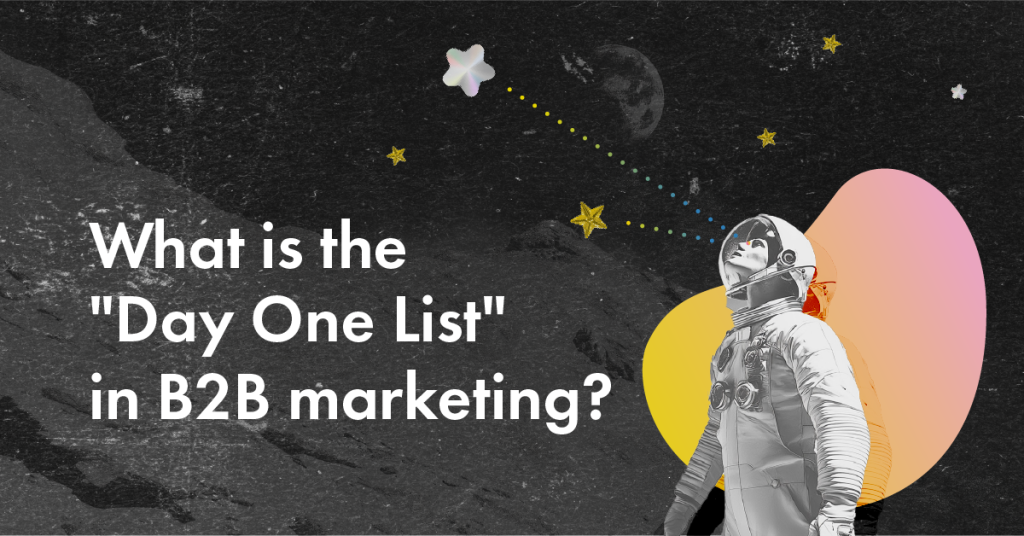
What is the “Day One List” in B2B marketing?
Published on 2 July, 2025 | Author: Digitalzone
In marketing, it’s every brand’s goal to be noticed—but few actually make it to the top of a buyer’s mind. That’s where the concept of the “Day One List” comes into play. While many marketers are familiar with terms like ICP (Ideal Customer Profile), ABM (Account-Based Marketing), and target accounts, the Day One List is a different—and arguably more powerful—concept. It’s not about who you’re targeting. It’s about whether your brand is the one that gets considered first when a decision is being made.
So, what exactly is the Day One List in B2B marketing? Let’s dive into it.
What is the Day One List?
The term “day one list” in B2B marketing and sales circles refers to the shortlist of vendors that a buyer subconsciously or deliberately creates at the very start of the procurement process.
In other words, before any formal process unfolds, buyers already have a set of companies in mind—a “day one list”—that they consider when they begin solving a business problem.
The “Day One List” concept in B2B marketing stems from the idea of mental availability, popularized by Byron Sharp in How Brands Grow. It emphasizes that brands easily recalled in buying situations are more likely to be chosen. As B2B marketers move beyond short-term lead generation toward long-term brand building, experts have helped popularize this shift.
Let’s bring it to life with a consumer example: imagine you’re thinking of buying a new smartphone. Instinctively, you might start comparing Apple and Samsung. You didn’t Google them. You didn’t consult a review site. They just popped into your head. That’s the Day One List in action. Those brands are considered without prompting.
In the B2B world, this works the same way. If a marketing leader is exploring new demand generation platforms, and they instantly think of HubSpot, Salesforce, or Marketo—that’s their Day One List for that category.
Why is the Day One List important in B2B?
Getting onto someone’s Day One List means you’ve won the awareness battle before the buying process even begins. You’re not just competing—you’re being automatically considered. That’s powerful.
Here’s why the Day One List matters:
- It drives first consideration: You’re in the initial evaluation without needing a cold email, an ad, or a sales call.
- It shortens the sales cycle: Being top-of-mind often means faster decision-making and less convincing.
- It boosts trust and authority: Buyers assume brands on their Day One List are proven, credible, and reliable.
- It increases win rates: If you’re on the shortlist from day one, you’re not fighting to get in—you’re fighting to win.
In B2B, where deals are complex and trust is critical, being remembered is more valuable than simply being visible.
How do brands make it to a Day One List?
Brands don’t just appear on a Day One List by accident. They earn their spot over time through consistent, high-quality interactions and reputation-building. While every buyer’s list will be slightly different, there are a few universal drivers that determine whether a brand gets considered from day one.
Let’s break them down:
1. Deliver exceptional quality, consistently.
Why it matters: quality is the foundation of trust. If your product or service doesn’t deliver, no amount of marketing can save it.
How to do it: ensure product reliability, invest in R&D, listen to customer feedback, and iterate quickly.
Example: Apple is known for sleek, high-performing devices. Customers know what to expect—every time.
2. Encourage and amplify positive word of mouth.
Why it matters: people trust people—especially friends, peers, and industry colleagues.
How to do it:
- Provide a stellar customer experience.
- Create shareable moments.
- Incentivize referrals and reviews.
Example: Dropbox famously grew by offering free storage for referrals—a simple way to turn users into evangelists.
3. Nail your reviews and ratings.
Why it matters: online reviews often serve as social proof in the decision-making process. They build credibility and reduce buyer hesitation.
How to do it:
- Proactively ask satisfied customers to leave reviews.
- Respond to negative reviews with transparency and action.
- Showcase testimonials on your website and landing pages.
Example: Amazon product rankings heavily influence what shoppers buy first—making reviews a critical factor.
4. Use celebrity or influencer endorsements wisely.
Why it matters: when done right, celebrity partnerships build aspirational value and trust through association.
How to do it:
- Align with personalities who reflect your brand values.
- Make sure it feels authentic—not just a paid placement.
- Combine celebrity reach with relatable storytelling.
Example: Nike and Michael Jordan—an iconic example of a long-term brand-building partnership.
5. Craft a memorable tagline or brand message.
Why it matters: taglines are mental hooks. A great one captures the essence of your brand in a few unforgettable words.
How to do it:
- Be concise and clear.
- Focus on emotional or functional benefits.
- Make it sticky and repeatable.
Examples:
- “Just Do It” (Nike)
- “Because You’re Worth It” (L’Oréal)
- Position your brand with precision.
Why it matters: strong brand positioning defines who you are, who you serve, and why you matter. It helps you stand apart in a sea of options.
How to do it:
- Define your unique value proposition.
- Own a category or niche.
- Communicate consistently across all touchpoints.
Example: Volvo = Safety. That’s a positioning they’ve owned for decades, and it’s still the first thing people associate with the brand.
Bonus: Be emotionally resonant.
People remember how you made them feel. Emotional connections forge loyalty, advocacy, and preference.
Whether it’s joy, empowerment, nostalgia, or innovation—make sure your brand taps into something deeper than features and functions.
Aim to be remembered.
The Day One List is a simple yet powerful mental model for B2B marketers. In a world overflowing with vendors and tech solutions, the ones that get considered first are the ones that win. Getting on that list is the result of long-term brand building, consistent value delivery, and staying relevant in the minds of your audience.
If you’re only focusing on being discoverable through outbound tactics, you’re too late. The real goal is to be so memorable, credible, and trustworthy that when a buyer finally thinks, “We need to solve this problem,”—your brand is the one they think of first.
The Day One List isn’t where the buying journey ends. But it’s absolutely where it starts.
